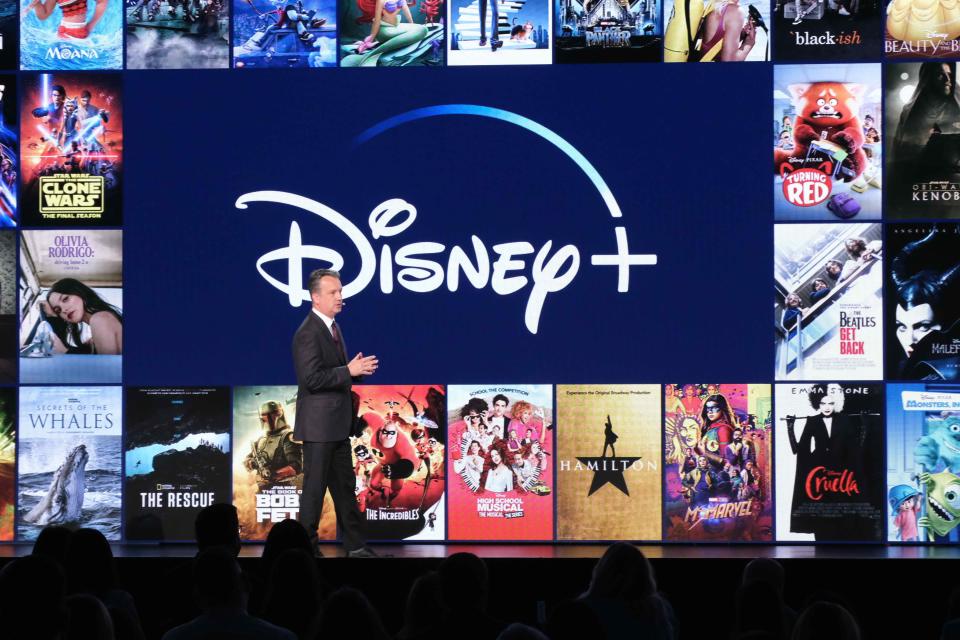Why Disney+ Will Make More Money on Ads Than Netflix Will

Advertising will play a key role in Netflix’s recovery from a disastrous first quarter — and from the streaming giant’s warning that Q2 will produce even greater subscriber losses. But a new report from the media analysts at MoffettNathanson further suggests that Netflix’s ad-supported future might not be a magic bullet and that Netflix’s chief competitor, Disney, stands to gain the most from the ads.
The researchers estimate Netflix could generate $1.2 billion in U.S. advertising revenue by 2025, which is equal to just 4 percent of the company’s worldwide revenue last year. For the Disney+ ad-supported tier, MoffettNathanson sees more revenue, more opportunities to monetize content, and a greater share of subscribers who will choose AVOD.
More from IndieWire
Ted Sarandos: Netflix Is Not 'Anti-Sports,' It's 'Pro-Profit'
'Wednesday' Boots 'Ozark' Season 4 from Netflix's All-Time Top 10 After 12 Days
The analysts there forecast Disney+ will make $1.8 billion from ads in 2025. The Disney-controlled Hulu, the industry leader in ad-supported streaming revenue, is projected to make $4.1 billion in ads that year. Combine the respective forecasts for HBO Max and Discovery+ — which seems reasonable to do given their pending combination — and Netflix’s projected domestic ad revenue in 2025 beats out only Paramount+ (just over $1 billion) among the major streamers.
Second-to-last place isn’t a great look for Netflix, but according to another key metric its leadership position within the streaming industry remains secure. Netflix already generates more average revenue per user (ARPU) than its competitors, and MoffettNathanson expects that to continue in 2025 — but to put it another way, it means Netflix is expensive.
In the U.S. that year, the analysts expect Netflix will bring in $19 per ad-free user, versus $15 per ad-supported subscriber. Compare that to the projections for Disney+: $12 from ad-free users versus $11 from AVOD subscribers.
That’s based on estimates of future prices. Netflix currently runs $9.99 to $19.99 per month; ad-supported tiers will cost less than the respective ad-free tiers, of course. Disney+ costs $7.99 per month and MoffettNathanson expects that when Disney+ introduces advertising later this year, it will charge that current price for the ad-supported tier and a higher price for a version without ads.
“Netflix has already established really high recurring [ARPU] and doesn’t need to create a spin-down opportunity for their customers,” MoffettNathanson’s Michael Nathanson told IndieWire for this story. “In contrast, the other platforms need advertising to lower the cost of their streaming prices to customers.”

Disney General Entertainment
Netflix remains the most-watched major streaming platform, accounting for 47 percent of the overall ecosystem’s domestic streaming minutes. MoffettNathanson expects it will lose a few significant points of share to competitors over the next few years.
“Because of faster forecasted subscriber growth at the other services, we forecast Netflix’s share of [total streaming minutes] to drop to the low 40s while each of the other services modestly grows their respective shares,” the group’s June 14 report reads.
Tuesday’s analysis came on the same day that more bad news landed for Netflix. Benchmark analyst Matthew Harrigan cut his rating on Netflix shares from “hold” to” sell,” admitting that he had made a mistake when he “prematurely” upgraded NFLX in January. Harrigan’s new target price is a pessimistic $157, beneath the company’s 52-week low of $162.71. The stock opened Wednesday at $169.26.
Even Bela Bajaria, Netflix’s global TV chief, called the previously untouchable streaming king an “underdog” during a keynote at Banff Media Festival on Tuesday. Ah, to rewind. Last October, Netflix briefly traded at $700 and its share price has plunged over 70 percent this year. Goldman Sachs last week also downgraded Netflix, citing concerns about slowing consumer spending and increased competition from Amazon and Disney.
Perhaps an underdog in some ways now, the home to “Stranger Things” is still the streaming leader with 221.64 million global subscribers (Disney has 205.6 million across Disney+, Hulu, and ESPN+). On the same day that MoffettNathanson published its report, Bajaria made her remark, and Harrigan downgraded NFLX, the company announced a new viewership record for “Stranger Things 4.” So it’s not all bad — but some of it definitely is.
Another major issue is the fact that Netflix isn’t really ready for AVOD and Disney is. The home to Disney+, Hotstar, and Hulu will be able to more quickly monetize U.S. ads thanks to a bundled sales approach with its linear networks and a robust internal advertising infrastructure that Netflix currently lacks. Whether an in-house or third-party solution, it’s expensive. Netflix also might lack the rights to insert ads into some third-party programming, which would handcuff its ability to specifically monetize anything beyond originals.
Netflix’s strength lies in its “potential for much larger global ad growth,” according to Nathanson’s group. Another recent report, from Wells Fargo, estimates that Netflix could generate $7.09 billion from ads globally in 2025, accounting for 15 percent of $44.8 billion in total revenue.
Looking ahead to 2025, MoffettNathanson expects 70 percent of the 53 million domestic Disney+ subscribers will be on an ad-supported tier. Over at Netflix, analysts expect just under 20 percent of an estimated 75.6 million subscribers to be watching ads.
Best of IndieWire
The Best True Crime Streaming Now, from 'Unsolved Mysteries' to 'McMillions' to 'The Staircase'
'The Last of Us' Sets Early 2023 Release at HBO: Here's Everything You Need to Know
Sign up for Indiewire's Newsletter. For the latest news, follow us on Facebook, Twitter, and Instagram.

